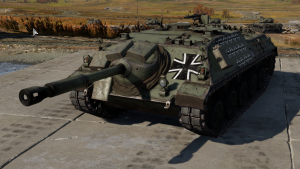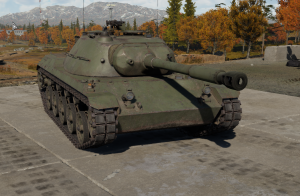Difference between revisions of "BK90 (90 mm)"
(→See also) (Tag: Visual edit) |
(added history) (Tag: Visual edit) |
||
| Line 79: | Line 79: | ||
== History == | == History == | ||
| − | + | ||
| + | The first prototypes of the Kanonenjagdpanzer were built in 1960 by Hanomag and Henschel for West Germany and by MOWAG for Switzerland. Between 1966 and 1967, 770 units were built for the Bundeswehr, 385 by Hanomag and 385 by Henschel. Eighty of them were delivered to Belgium from April 1975 onward. | ||
| + | |||
| + | When the Soviets began deploying their T-64 and T-72 main battle tanks, the 90 mm gun was not capable of engaging them in long-range combat and the Kanonenjagdpanzer became obsolete. Although the producers claimed it could be rearmed with a 105 mm gun, between 1983 and 1985, 163 of these tank destroyers were converted into Raketenjagdpanzer Jaguar 2 anti-tank guided missile carriers by removing the gun, adding a roof-mounted TOW missile launcher and fastening further spaced and perforated armour on the hull. Some others were refitted into artillery observation vehicles by removing the main gun, so called Beobachtungspanzer, which served most particularly in the mortar units. | ||
| + | |||
| + | Some Kanonenjagdpanzer remained in service with the Heimatschutztruppe until 1990.<ref>https://en.wikipedia.org/wiki/Kanonenjagdpanzer</ref> | ||
| + | |||
| + | == ''Design'' == | ||
== Media == | == Media == | ||
Revision as of 14:39, 27 February 2021
Contents
Description
The BK90 is a German modification of the American 90 mm gun M1/M2/M3 taken from old M47s. It has access to APCR, HEATFS and HESH which is the only new round.
Vehicles equipped with this weapon
General info
Tell us about the tactical and technical characteristics of the cannon or machine gun.
Available ammunition
| Penetration statistics | |||||||
|---|---|---|---|---|---|---|---|
| Ammunition | Type of warhead |
Penetration @ 0° Angle of Attack (mm) | |||||
| 10 m | 100 m | 500 m | 1,000 m | 1,500 m | 2,000 m | ||
| M332 shot | APCR | 291 | 286 | 264 | 240 | 217 | 197 |
| M431 shell | HEATFS | 320 | 320 | 320 | 320 | 320 | 320 |
| M71 shell | HE | 13 | 13 | 13 | 13 | 13 | 13 |
| DM502 | HESH | 102 | 102 | 102 | 102 | 102 | 102 |
| Shell details | |||||||||
|---|---|---|---|---|---|---|---|---|---|
| Ammunition | Type of warhead |
Velocity (m/s) |
Projectile Mass (kg) |
Fuse delay (m) |
Fuse sensitivity (mm) |
Explosive Mass (TNT equivalent) (g) |
Ricochet | ||
| 0% | 50% | 100% | |||||||
| M332 shot | APCR | 1,165 | 5.7 | N/A | N/A | N/A | 66° | 70° | 72° |
| M431 shell | HEATFS | 1,216 | 5.8 | 0 | 0.1 | 712.64 | 65° | 72° | 77° |
| M71 shell | HE | 823 | 10.55 | 0 | 0.1 | 925 | 79° | 80° | 81° |
| DM502 | HESH | 853 | 10.6 | 0.05 | 0.1 | 3,050 | 73° | 77° | 80° |
Comparison with analogues
- M36 (90 mm) - American variant of the cannon, which the BK90 was derived from. Though it does not have the BK90's HESH round, it has a large variety of AP rounds for use.
Usage in battles
The BK90 with HEAT-FS is a formidable opponent on the battlefield that can penetrate every 6.7 tank's frontal armour at any range. It is best used in hit-n-run types of attack due to the vehicles it is mounted on.
Pros and cons
Pros:
- Access to HEATFS that can penetrate every tank that it typically has to face
Cons:
- Limited kinetic ammunition variety - the only kinetic ammunition is APCR
- Of the chemical rounds available, only the HEAT-FS round is of noteworthy use
History
The first prototypes of the Kanonenjagdpanzer were built in 1960 by Hanomag and Henschel for West Germany and by MOWAG for Switzerland. Between 1966 and 1967, 770 units were built for the Bundeswehr, 385 by Hanomag and 385 by Henschel. Eighty of them were delivered to Belgium from April 1975 onward.
When the Soviets began deploying their T-64 and T-72 main battle tanks, the 90 mm gun was not capable of engaging them in long-range combat and the Kanonenjagdpanzer became obsolete. Although the producers claimed it could be rearmed with a 105 mm gun, between 1983 and 1985, 163 of these tank destroyers were converted into Raketenjagdpanzer Jaguar 2 anti-tank guided missile carriers by removing the gun, adding a roof-mounted TOW missile launcher and fastening further spaced and perforated armour on the hull. Some others were refitted into artillery observation vehicles by removing the main gun, so called Beobachtungspanzer, which served most particularly in the mortar units.
Some Kanonenjagdpanzer remained in service with the Heimatschutztruppe until 1990.[1]
Design
Media
See also
External links
| Germany tank cannons | |
|---|---|
| 20 mm | KwK30 · KwK38 · Rh202 |
| 28/20 mm | s.Pz.B.41 |
| 30 mm | MK 30-2/ABM |
| 37 mm | KwK34(t) · KwK36 · KwK38(t) · PaK L/45 |
| 47 mm | Pak.(t)(Sf.) |
| 50 mm | KwK39 · KwK L/42 · PaK38 |
| 57 mm | Bofors L/70 Mk.1 |
| 75 mm | K51 L/24 · KwK37 · KwK40 L43 · KwK40 L48 · KwK42 · KwK44 · KwK44 L/36.5 · PaK39 L48 · PaK40/3 L46 · PaK42 · StuK37 · StuK40 L43 · StuK40 L48 |
| 76 mm | PaK36 (r) |
| 88 mm | Flak.37 · Flak 41 · KwK36 · KwK43 · PaK43 |
| 90 mm | BK90 |
| 105 mm | CN105-57 · Cockerill HP · FMK.4 Modelo 1L · K.18 · KwK L/68 · L7A3 · PzK M57 · StuH42 |
| 120 mm | Rh120 L/44 · Rh120 L/55 · Rh120 L/55 A1 |
| 128 mm | K.40 · KwK44 · PaK44 |
| 150 mm | s.I.G.33 · Stu.H 43 L/12 |
| 380 mm | RW61 |
| Foreign: | |
| 30 mm | Bushmaster 2 Mk.44 (USA) · HSS 831L (Britain) |
| 57 mm | 6pdr OQF Mk.V (Britain) |
| 73 mm | 2A28 (USSR) |
| 75 mm | M3 (USA) |
| 76 mm | F-32 (USSR) · F-34 (USSR) · M32 (USA) |
| 90 mm | M36 (USA) · M41 (USA) |
| 105 mm | GT-3 (South Africa) |
| 125 mm | 2A46 (USSR) |
| 152 mm | M-10T (USSR) · XM150E5 (USA) |
| 155 mm | M126 (USA) |





